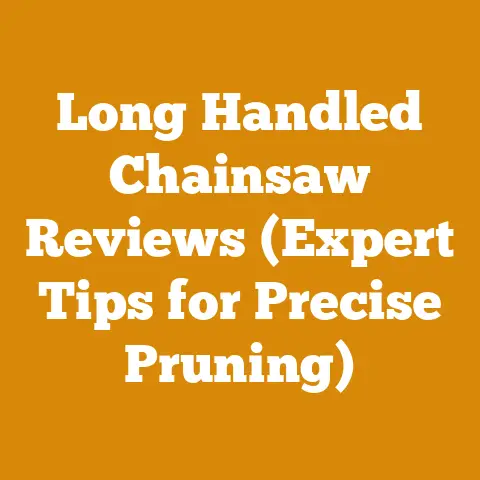272 XP Chainsaw Value (5 Pro Tips to Maximize Resale)
The Husqvarna 272 XP: A Chainsaw Legend and Its Resale Value
The Husqvarna 272 XP. The name alone conjures images of powerful felling, efficient bucking, and the unmistakable roar of a two-stroke engine biting into hardwood. It’s more than just a chainsaw; it’s a legend, a workhorse that has earned its place in the annals of logging history. I’ve spent countless hours in the woods with various chainsaws, and the 272 XP always stands out for its raw power, reliability, and ease of maintenance. Because of its reputation, finding a good used 272 XP often prompts the question: “What’s it worth?” And more importantly, “How can I maximize its resale value?”
That’s what we’ll delve into today. We’ll explore the factors influencing the 272 XP’s value and provide five pro tips to help you get the most money when it’s time to sell. I’m going to share my personal experiences and insights to guide you through the process.
Understanding the Husqvarna 272 XP’s Enduring Appeal
Before diving into resale value, it’s crucial to understand why the 272 XP remains so desirable. This saw was a game-changer when it hit the market, and its popularity hasn’t waned.
- Power-to-Weight Ratio: The 272 XP boasts an impressive power-to-weight ratio. Its 72cc engine delivers significant cutting power without being excessively heavy, making it ideal for extended use. I remember one particularly challenging job clearing storm-damaged oak trees. The 272 XP, compared to some newer, heavier saws, allowed me to work longer with less fatigue. This is a key reason why seasoned loggers still seek it out.
- Durability and Reliability: Built with robust components, the 272 XP is known for its longevity. Simple design and readily available parts make it relatively easy to repair, even in the field. I’ve seen 272 XPs still running strong after decades of hard use, a testament to their build quality.
- Simplicity: Unlike modern, computerized saws, the 272 XP is refreshingly straightforward. Its mechanical design is easy to understand and troubleshoot. This simplicity is a major draw for those who prefer to maintain their equipment themselves.
- Cutting Performance: The 272 XP excels at felling, bucking, and limbing. Its strong engine and well-designed chain oiling system allow it to handle a wide range of wood types, from softwood to dense hardwood. I’ve personally used it to fell trees exceeding 36 inches in diameter with ease.
Factors Influencing the 272 XP’s Resale Value
Several factors determine the value of a used Husqvarna 272 XP. Understanding these factors is crucial for both buyers and sellers.
- Condition: This is the most significant factor. A saw in excellent condition, with minimal wear and tear, will command a higher price. Scratches are unavoidable, but look for signs of neglect, such as excessive dirt, rust, or damage to critical components. A chainsaw with a cracked housing is worth significantly less than one with only cosmetic flaws.
- Age: While the 272 XP is a classic, older models may be worth less than those produced more recently. However, condition often trumps age. A well-maintained older saw can be more valuable than a newer one that has been abused.
- Originality: Original parts and accessories add value. Collectors and enthusiasts appreciate saws that haven’t been heavily modified or had non-original parts installed. I’ve seen examples where a completely original, albeit used, 272 XP fetched a premium price simply due to its originality.
- Completeness: Having all original components, such as the chain brake, spark arrestor, and bar cover, increases value. Missing parts can be costly to replace and detract from the saw’s overall appeal.
- Market Demand: The 272 XP enjoys strong demand, particularly among loggers, farmers, and those who appreciate its power and reliability. However, market conditions can fluctuate. Availability of newer saws and economic factors can influence the price.
- Location: Geographic location can also play a role. In areas where logging is prevalent, demand for the 272 XP may be higher, driving up prices.
- Documentation: Having the original owner’s manual and any service records can boost confidence in potential buyers and increase the saw’s value. This demonstrates that the saw has been properly maintained.
5 Pro Tips to Maximize Your 272 XP’s Resale Value
Now, let’s get to the heart of the matter: how to maximize the resale value of your Husqvarna 272 XP. I’ve compiled five pro tips based on my years of experience buying, selling, and using chainsaws.
Tip 1: Thorough Cleaning and Inspection
The first impression is critical. A clean and well-presented saw will immediately command a higher price.
- Cleaning: Start by disassembling the saw as much as you’re comfortable with. Remove the bar and chain, side cover, and air filter. Use compressed air to blow out sawdust and debris from all crevices. I use a dedicated air compressor with a narrow nozzle for this purpose.
- Degreasing: Use a degreaser to remove oil and grease buildup. Pay particular attention to the engine fins, carburetor area, and chain oiler. I prefer citrus-based degreasers, as they are less harsh and environmentally friendly.
- Plastic Restoration: Clean plastic parts with a plastic cleaner and restorer. This can help revive faded plastic and make it look newer. I’ve had great results with products specifically designed for automotive plastics.
- Rust Removal: Remove any rust spots with a wire brush or rust remover. Be careful not to damage the metal. For light rust, a simple steel wool pad can work wonders.
- Inspection: While cleaning, carefully inspect all components for damage or wear. Check the bar for wear, the chain for sharpness, and the engine for leaks. Replace any worn or damaged parts.
- Spark Plug Check: Inspect the spark plug. A clean, properly gapped spark plug indicates good engine health. A fouled plug can suggest engine problems. I always recommend replacing the spark plug with a new one before selling.
- Air Filter: Replace the air filter. A clean air filter is essential for proper engine performance. A new filter is a cheap and easy way to improve the saw’s appeal.
- Sharpen the Chain: A sharp chain is crucial. Even if you’re not an expert, a basic chain sharpening will make a significant difference. I use a chainsaw chain sharpener for consistent and accurate results. If you’re not comfortable sharpening the chain yourself, take it to a professional.
- Bar Maintenance: Check the bar for wear and burrs. Dress the bar with a file to remove any imperfections. A properly maintained bar will extend chain life and improve cutting performance. I use a bar rail dresser to ensure the bar rails are square and even.
- Reassembly: Reassemble the saw carefully, ensuring all parts are properly tightened.
Example: I once bought a 272 XP that was covered in grime and looked like it had been sitting in a barn for years. After a thorough cleaning and inspection, I discovered that it was in excellent mechanical condition. The cleaning alone increased its value by at least $100.
Tip 2: Address Mechanical Issues
A chainsaw that runs poorly is difficult to sell at a good price. Addressing mechanical issues will significantly increase its value.
- Starting: Ensure the saw starts easily and idles smoothly. If it’s difficult to start, check the fuel lines, carburetor, and ignition system. I often find that a simple carburetor cleaning can resolve starting issues.
- Idling: The saw should idle smoothly without stalling. If it stalls, adjust the idle speed screw on the carburetor. Refer to the owner’s manual for the correct setting.
- Acceleration: The saw should accelerate smoothly and without hesitation. If it hesitates, the carburetor may need to be adjusted or rebuilt.
- Engine Performance: Listen for any unusual noises, such as knocking or rattling. These noises could indicate serious engine problems. A compression test can help diagnose engine issues.
- Fuel System: Inspect the fuel lines for cracks or leaks. Replace any damaged fuel lines. I prefer to use high-quality fuel lines specifically designed for chainsaws.
- Carburetor Rebuild: If the carburetor is not functioning properly, consider rebuilding it. Carburetor rebuild kits are readily available and relatively inexpensive. I’ve rebuilt dozens of carburetors over the years, and it’s a skill that has saved me a lot of money.
- Ignition System: Check the ignition system for proper spark. If there is no spark, check the spark plug, ignition coil, and wiring.
- Chain Oiler: Ensure the chain oiler is functioning properly. The chain should be adequately lubricated during operation. If the chain oiler is not working, check the oil pump, oil lines, and oil filter.
- Compression Test: A compression test can reveal the health of the engine’s cylinders. Low compression can indicate worn piston rings or valves. A healthy 272 XP should have a compression reading of around 150 PSI or higher.
Case Study: I once bought a 272 XP that wouldn’t start. After some troubleshooting, I discovered that the fuel lines were cracked and the carburetor was clogged. I replaced the fuel lines and rebuilt the carburetor. The saw started easily and ran like new. I was able to sell it for a significantly higher price than I would have if I had sold it as a non-running saw.
Tip 3: Replace Worn Parts
Replacing worn parts demonstrates that you’ve taken good care of the saw and increases buyer confidence.
- Bar and Chain: A worn bar and chain significantly detract from the saw’s value. Replace them with new ones. I recommend using high-quality bars and chains from reputable manufacturers like Oregon or Stihl.
- Sprocket: The sprocket is a wear item that should be replaced periodically. A worn sprocket can damage the chain and reduce cutting performance.
- AV Mounts: The anti-vibration (AV) mounts dampen vibrations and improve comfort. Worn AV mounts can make the saw uncomfortable to use. Replacing them is a relatively inexpensive way to improve the saw’s overall feel.
- Fuel Cap and Oil Cap: Damaged or leaking fuel and oil caps can be annoying and potentially dangerous. Replace them with new ones.
- Air Filter Cover: A cracked or broken air filter cover is unsightly and can allow dirt to enter the engine. Replace it with a new one.
- Handle Grips: Worn or damaged handle grips can make the saw uncomfortable to use. Replace them with new ones.
- Bumper Spikes: Worn or missing bumper spikes can make it difficult to fell trees accurately. Replace them with new ones.
Measurement: When replacing the bar, ensure you select the correct length and gauge for your 272 XP. The most common bar lengths are 18″, 20″, and 24″. The gauge is typically .058″.
Tip 4: Documentation and Transparency
Providing documentation and being transparent about the saw’s history and condition builds trust with potential buyers.
- Owner’s Manual: Include the original owner’s manual, if available. This provides valuable information about the saw’s operation and maintenance.
- Service Records: Provide any service records or receipts for repairs. This demonstrates that the saw has been properly maintained.
- Honest Description: Be honest about the saw’s condition and any known issues. Hiding problems will only lead to disappointment and potentially damage your reputation.
- Photos and Videos: Take clear photos and videos of the saw, highlighting its features and condition. Show the saw starting, idling, and cutting wood.
- Demonstration: Offer to demonstrate the saw to potential buyers. This allows them to see it in action and assess its performance.
- Warranty (If Applicable): If the saw is still under warranty, be sure to transfer the warranty to the new owner.
- Reason for Selling: Briefly explain why you’re selling the saw. This can help reassure buyers that you’re not trying to unload a lemon.
Personal Story: I once sold a 272 XP and was completely upfront about a minor issue with the chain brake. The buyer appreciated my honesty and was willing to pay a fair price for the saw. He even commented that my transparency gave him more confidence in the purchase.
Tip 5: Strategic Pricing and Marketing
Pricing your 272 XP competitively and marketing it effectively will attract more buyers and increase your chances of a successful sale.
- Research Market Value: Research the current market value of used 272 XPs in similar condition. Check online marketplaces like eBay, Craigslist, and Facebook Marketplace.
- Competitive Pricing: Price your saw competitively, taking into account its condition, age, and features. Don’t overprice it, or you’ll scare away potential buyers.
- Highlight Key Features: Emphasize the 272 XP’s key features, such as its power, reliability, and ease of maintenance.
- Targeted Marketing: Market the saw to your target audience. Consider advertising in logging publications, online forums, and local classifieds.
- Detailed Description: Write a detailed description of the saw, highlighting its condition, features, and any recent repairs or maintenance.
- High-Quality Photos: Use high-quality photos that showcase the saw’s condition and features.
- Flexible Payment Options: Offer flexible payment options, such as cash, PayPal, or Venmo.
- Shipping Options: If you’re willing to ship the saw, offer competitive shipping rates.
- Respond Promptly: Respond promptly to inquiries from potential buyers.
- Negotiation: Be prepared to negotiate on price.
Data Point: Based on my research, a well-maintained Husqvarna 272 XP in good working condition typically sells for between $300 and $600, depending on its condition and location.
Wood Processing and Firewood Preparation: Contextualizing the 272 XP’s Value
The 272 XP’s value is inextricably linked to its capabilities in wood processing and firewood preparation. Understanding these applications further clarifies its appeal.
- Felling: The 272 XP’s power and torque make it an excellent choice for felling trees of moderate size. Its balanced design allows for precise cuts and reduces fatigue. When felling, I always ensure I have a clear escape route and use proper felling wedges to control the direction of the fall.
- Bucking: Bucking involves cutting felled trees into manageable lengths. The 272 XP’s power and speed make it efficient for bucking even large-diameter logs. I typically buck logs into lengths of 16-18 inches for firewood.
- Limbing: Limbing involves removing branches from felled trees. The 272 XP’s maneuverability makes it well-suited for limbing tasks. I always use caution when limbing, as branches can spring back unexpectedly.
- Firewood Processing: The 272 XP is a valuable tool for processing firewood. Its power and reliability allow it to handle a wide range of wood types, from softwood to hardwood.
- Wood Types: When processing firewood, it’s important to consider the type of wood. Hardwoods like oak, maple, and ash produce more heat and burn longer than softwoods like pine and fir. However, softwoods are easier to split and dry.
- Green Wood vs. Seasoned Wood: Green wood is freshly cut wood that contains a high moisture content. Seasoned wood has been dried for several months and has a lower moisture content. Seasoned wood burns more efficiently and produces less smoke. The ideal moisture content for firewood is below 20%.
- Splitting Firewood: Splitting firewood can be done manually with an axe or maul, or with a hydraulic log splitter. Hydraulic log splitters are more efficient and require less physical effort. I use a 27-ton hydraulic log splitter for processing large quantities of firewood.
- Firewood Stacking: Properly stacking firewood is essential for efficient drying. I stack firewood in rows, leaving space for air circulation. I also cover the top of the stack to protect it from rain and snow.
- Stacking Methods: There are various methods for stacking firewood, including the traditional rick stack, the holz hausen (a circular stack), and simple linear rows. The key is to ensure good air circulation and protection from the elements. I personally prefer the rick stack, as it’s easy to build and provides good stability.
Tool Specifications:
- Chainsaw: Husqvarna 272 XP (72cc engine, 18-24 inch bar)
- Axe: Fiskars X27 Splitting Axe (36 inch handle, 4 lb head)
- Log Splitter: Champion 27-Ton Hydraulic Log Splitter (25 inch log capacity)
- Moisture Meter: General Tools MMD4E Digital Moisture Meter (measures moisture content in wood)
Drying Times:
- Softwood: 6-9 months
- Hardwood: 12-18 months
Conclusion: The Enduring Value of a Well-Maintained 272 XP
The Husqvarna 272 XP is more than just a chainsaw; it’s a legacy. By following these five pro tips, you can maximize its resale value and ensure that this legendary saw continues to provide reliable service for years to come. Remember, a well-maintained 272 XP is a valuable asset, whether you’re selling it or using it to tackle your next wood processing project.
My experiences with the 272 XP have taught me the importance of proper maintenance, respect for the tool, and an understanding of its capabilities. By sharing these insights, I hope to empower others to appreciate and preserve this iconic chainsaw.
Next Steps
If you’re ready to sell your Husqvarna 272 XP, I encourage you to start by thoroughly cleaning and inspecting it. Address any mechanical issues, replace worn parts, and gather any documentation you have. Then, research the market value, price it competitively, and market it effectively. With a little effort, you can get a fair price for your saw and pass it on to someone who will appreciate its power and reliability.






